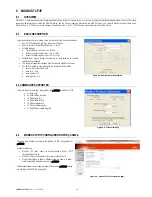
pCOWeb
+030220966 – rel. 1.1 – 12.12.2017
50
IMPORTANT
•
For this information
pCOWeb
is case sensitive!
•
The changes will be active as soon as they are confirmed;
pCOWeb
does not need to be rebooted.
•
Using the button when rebooting
pCOWeb
(see 3.1.2 on page 12) causes no variations in the restrictions: those already set are still valid.
•
The Username and Password fields of an already created restriction will be displayed as empty anyway.
•
Selecting Submit creates the restriction even if the fields are empty; during authentication, the corresponding fields should be left empty.
•
To skip the creation of the access restriction, close the dialogue box without pressing “Submit”.
Directory list (
Figure 9.s
)
pCOWeb Main: used to set the Username/Password for the HTML pages contained in the /usr/local/root/flash/http directory (no effect on subdirectories).
pCOWeb Config: used to set the Username/Password for the HTML pages contained in the /usr/local/root/config directory
log / admin / plugins / …: list of the directories and related subdirectories contained in /usr/local/root/flash/http (the index_img directory will not be
displayed); the list shows both the directories with active restrictions and those without restrictions.
The Username/Password for the selected directory can be set and/or changed.
TIP
Symlinks can be used to attribute the same authentication to multiple directories: after having generated, for a directory, the .htpasswd file as shown in
Figure
9.s
on page 49, simply add a link in each directory (symbolic link, typical of Unix-like systems) to the .htpasswd file generated.
For example, to share the .htpasswd file located in /usr/local/root/flash/http/admin/ for the /usr/local/root/flash/http/ directory, proceed as follows:
1.
from a Windows terminal access
pCOWeb
by selecting Accessories / Prompt and then entering:
telnet 10.10.7.132 (IP address or name of the
pCOWeb
);
2.
at the login request, type:
httpadmin
and the password (see 9.8.2);
3.
type:
cd /usr/local/root/flash/http/
(new directory for sharing the same Username and Password as /usr/local/root/flash/http/admin);
4.
type:
ln -s /usr/local/root/flash/http/admin/.htpasswd
.htpasswd
(this creates a link called “.htpasswd” that points to the /usr/local/root/flash/http/admin/.htpasswd file generated previously).
REMOVING AN HTML ACCESS RESTRICTION
The only way to remove access restrictions that have already been set for the HTML pages contained in a directory is to access the
pCOWeb
memory via
FTP or SCP (see 0 on page 18) and manually delete the .htpasswd file in the directory in question.
IMPORTANT: If the file you need to send with a notification event is placed in a directory with a password request, the notification will not be sent.
9.8.2
Users of the operating system
The functions of the GNU/Linux operating system that
pCOWeb
is based on can be accessed by logging in with one of the following four default, non-
modifiable usernames:
Username
Password when starting without pressing the button:
default value (modifiable)
Password when starting with the button
(see 3.1.2 on page 12) (non-modifiable)
root froot
froot
httpadmin fhttpadmin
fhttpadmin
carel fcarel
fcarel
guest fguest
fguest
Table 9.a - Operating system Usernames and Passwords
A modifiable Password is provided as default for each of the four users. The modification does not affect the password that is used to access
pCOWeb
when started
with the button pressed (see 3.1.2 on page 12), which is non-modifiable. The Password can be modified to allow only authorised personnel to access
pCOWeb
.
IMPORTANT
•
For this information
pCOWeb
is case sensitive!
•
The changes will be active as soon as they are confirmed;
pCOWeb
does not need to be rebooted.
Figure 9.t - Changing the password for the operating system access Usernames






























